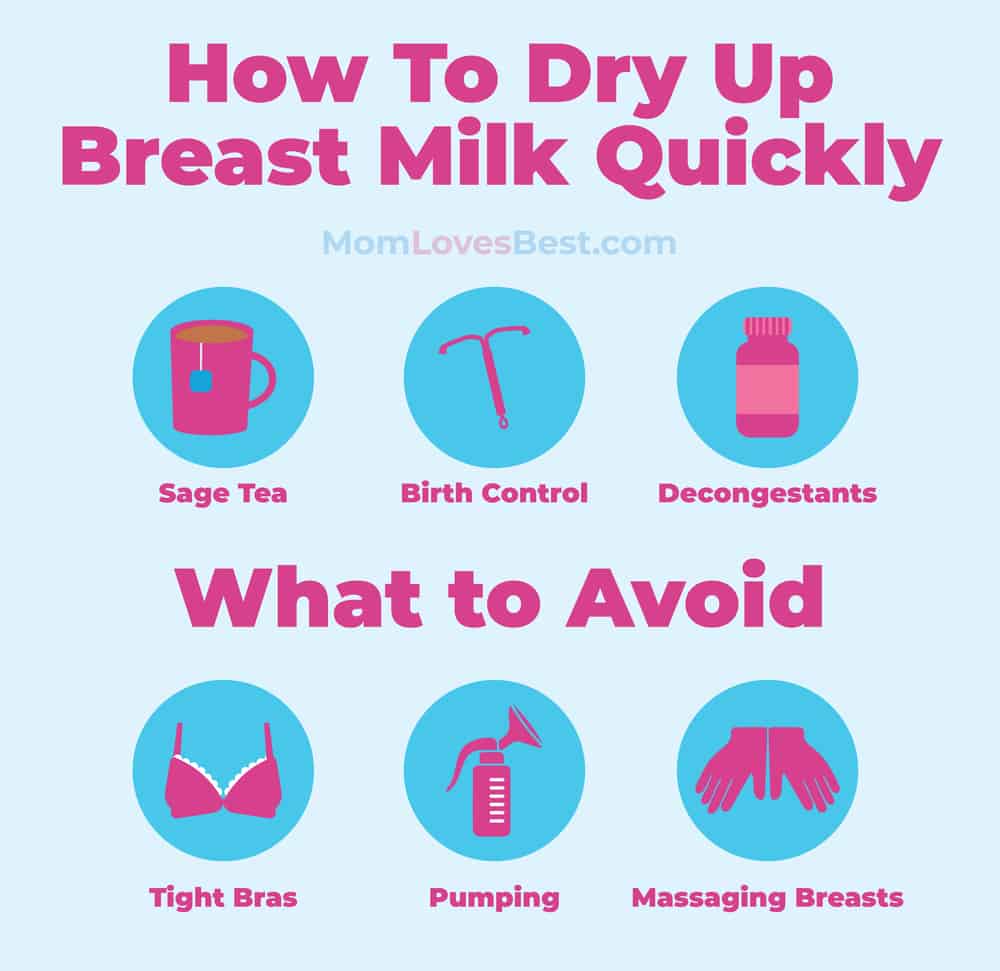How To Get Rid Of Breast Milk
Have you decided to switch your baby to formula, but find your breasts still engorged? Or maybe your nursing baby has now weaned, and you need your milk to dry up?
I've been there, I know the pain of engorgement and the struggle of trying to dry up breast milk.
My son weaned himself at 14 months, and it was glorious. My youngest, on the other hand, had some medical issues — nursing was her main comfort. I was afraid she might never stop nursing, until her doctor told us we had to wean suddenly when she was 22 months old.
So what can you do to ease the weaning process and dry up your breast milk supply? What helps? What hurts? Let's find out.
- Avoid Weaning Baby Cold Turkey
- How To Dry Up Breast Milk
- What To Avoid When Drying Breast Milk
- Reducing Breast Pain While Weaning
- When The Breast Isn't Best…
Avoid Weaning Baby Cold Turkey
If you're ready to stop breastfeeding, the idea of saying goodbye to it all at once and never looking back might seem enticing. However, if you have the option of doing a slow and steady wean, it's encouraged that you do so.
Although stopping breastfeeding suddenly can feel like the best option for you and your child, it can also come with serious complications.
Breast milk is made on a "supply and demand" basis. The more you nurse, the more milk your body produces (1). If you stop nursing abruptly, your body doesn't immediately know to stop producing breast milk at the same rate it has been making it.
This can lead to painful breast engorgement and, in severe cases, mastitis (breast infection).
By weaning over a few weeks, your body will naturally begin to understand that the need for breast milk is less, and will produce less as a result.
Some steps you can take to wean your little one off the breast gradually include:
- Replace Breastfeeding Sessions: Gradually replace one daily breastfeeding at a time with solids or liquids, such as baby food or iron-fortified formula.
- Go Slow and Steady: Once you've replaced one breastfeeding session with a meal, wait for 3 to 5 days before swapping another breastfeeding for baby food.
- Cuddle for Comfort: Spending close time with your little one will assure them your love and affection is constant, even through this change. This may also help prevent post-weaning depression for you.
How To Dry Up Breast Milk
Is your milk not drying up as fast as you'd like, even though baby is nursing less and less? Or maybe you're in a situation like I was, where I had to wean suddenly and my body was just not getting the message!
Thankfully, there are a few things that you can try to help your milk dry up faster:

1. Sage Tea
Sage helps to dry up breast milk because it contains a natural form of estrogen (2). If you already have dried sage in your pantry, you can use it by simply steeping a teaspoon of in a cup of hot water for about 15 minutes.
Drink one glass of sage tea every 6 hours for best results. This tea can be very bitter, so add a little honey, sugar, or your sweetener of choice to make it more palatable.
2. Birth Control
If you've been taking birth control pills while breastfeeding, chances are your doctor has made sure to put you on a progestin-only version.
This is because estrogen-based birth control options have been linked to low milk supply in nursing moms (3). If your milk isn't drying up quite as quickly as you'd like it to, it might be a good idea to switch to an estrogen-based contraceptive to help move the process along.
Because hormonal birth control has side effects of its own, this should be a last resort.

Editor's Note:
Michelle Roth, BA, IBCLC
3. Decongestants
When you have a cold, decongestants work by opening up passageways and drying up the mucus being produced (4). They are normally not recommended for use while breastfeeding because they can also tend to dry up other bodily fluids, including breastmilk.
This is often a "last resort" method for frustrated mamas. If you want a boost to help dry up your milk faster, a decongestant such as pseudoephedrine might help.
Important Note
Before going this route talk to your doctor, because decongestants can have severe side effects if not taken carefully.
What To Avoid When Drying Breast Milk
For as many dos are when for weaning your baby and drying up your breast milk, there are also many don'ts.
A few practices to avoid during the weaning and drying-up period are:
1. Tight Bras And Binding
If you've told anyone that you are trying to wean off breastfeeding, they might suggest you bind your breasts as a way to suppress your milk supply. This is typically a bad idea.
Binding your breasts can cause engorgement to get worse and increase your risk of getting mastitis.
2. Pumping
As you decrease your nursing sessions, it's normal for your body to need time to adjust to the change. This might result in your breasts feeling full and engorged between nursing sessions, until your body gets the memo to slow down milk production.
It might be tempting to pump in between nursing sessions to ease the pressure, but try to avoid it as best you can. Pumping will have the same effect as nursing on your body — sending that pesky "demand" signal — making the process of decreasing your milk supply take longer.
3. Massaging Your Breasts
When your back hurts you massage it, and you might be tempted to do the same for your breasts when they're full during weaning. But did you know even touching your breasts when they're full can signal your body to let down the milk, just as if you were nursing?
The more stimulation your breasts receive, the more milk your body will think it needs to produce. This is exactly the opposite of what you want to happen. It's best to keep hands off of your breasts (including when you're intimate with your partner) while you try to decrease your supply.
Not to worry — there are other ways to find relief!
Reducing Breast Pain While Weaning
The difficulties of weaning may only seem more frustrating with the pain and discomfort engorgement can cause. During this period of change, it's key to take care of yourself to ensure the transition is as gentle as possible for you and baby.
If you're experiencing breast pain during the weaning period, here are some ways to reduce and manage it:
1. Hot Showers
If your breasts are swollen and engorged, a hot shower might help provide some relief.
Some say to avoid hot showers because the warm water can cause milk to leak out of your breasts. However, if you keep your shower short, this will not cause your body to produce more milk.
2. Cabbage Leaves
I thought my grandmother was crazy when she told me I could relieve some of the discomfort of engorgement with cabbage leaves. Let me tell you — by day four of zero nursing, I was willing to try anything, even if it left me smelling like my aunt's house on New Year's Day.
Surprisingly, my grandmother was right. Refrigerated cabbage leaves placed inside your bra can ease the pain caused by engorgement.
Some steps to remember for this method:
- Wash: Separate and wash the leaves of a green cabbage, thoroughly drying them afterward.
- Refrigerate: Store your freshly washed leaves in the fridge until ready for use.
- Crush: Before placing the leaves inside of your bra, crush the veins of the cabbage with a rolling pin or carefully cut them open with a knife. Insert leaves into bra with cabbage veins against skin.
- Repeat: Leave on for 20-30 minutes, repeating with fresh leaves up to 4 times in a 24-hour period, until engorgement is reduced.
Cabbage Caution
Some say that the cabbage leaves will help your milk to dry up quickly — although studies don't know why. Don't use this method for more than 24 hours at a time if you're still partially nursing (5).
3. Pain Medications
Over-the-counter pain medications won't make engorgement go away completely, but they can help reduce swelling and reduce the pain that comes with it.
Both acetaminophen and ibuprofen can be purchased in your local pharmacy, and are safe to use whether you're slowly weaning breastfeeding or quitting altogether.
Ibuprofen is the active ingredient in Advil and Motrin, and is typically favored for its anti-inflammatory properties.
4. Cold Packs
Cold packs work similarly to cabbage leaves, helping to reduce the pain and swelling engorgement can cause. Whether you choose crushed ice, bags of frozen peas, or ice packs, they can bring comfort faster than pain-relieving medications, and can be used side-by-side with them for longer-lasting relief.
Unlike cabbage leaves, there's no chance these will help dry up your milk faster, but they can provide comfort while your body does the work naturally.
When The Breast Isn't Best…
It doesn't matter when or why you decide to stop breastfeeding your baby. Whether it's for medical reasons, going back to work, or feeling it's time to stop, it's a very personal decision only you can make.
It's key to remember there are ways to reduce the emotional and physical discomfort weaning and drying your breast milk can bring.
Speak to other moms, spend time cuddling and engaging your child in other activities, and stock your fridge with cabbage — you can continue to nurture your changing relationship while staying comfortable.
Do you have tips for moms who are looking to ease the pain of engorgement and dry up their breast milk? We'd love to hear your thoughts.
How To Get Rid Of Breast Milk
Source: https://momlovesbest.com/dry-up-breastmilk
Posted by: dorroughundfuld.blogspot.com

0 Response to "How To Get Rid Of Breast Milk"
Post a Comment